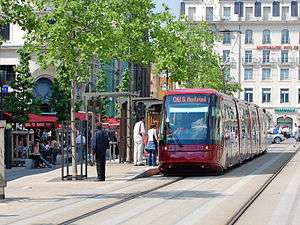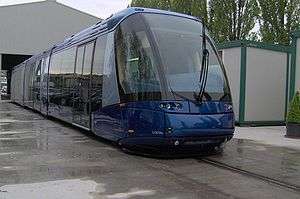Translohr

Translohr is the name of a rubber-tired tramway (or guided bus) system originally developed by Lohr Industrie of France and now by a consortium of Alstom and Fonds stratégique d'investissement (FSI) as newTL[1] (taking over from Lohr in 2012). It is used in Clermont-Ferrand, Medellín, Tianjin, Shanghai, Padua, Paris and in the Venice-Mestre district.[2]
Description

The Translohr system is intended to provide a much more tram or light rail-like experience than that provided by regular buses. Unlike other guided bus systems (including the similar but incompatible Guided Light Transit system developed by Bombardier Transportation), Translohr cars are permanently fixed to following a guide rail and cannot divert from it, as is the case with traditional steel-wheeled rail vehicles.
With the guide rail automatically guiding the vehicle along its route, there are no steering controls in the driver's cab (although acceleration and braking are controlled by foot pedals, as in a standard bus). Like a conventional tram, power is provided by overhead wires and collected with a pantograph, although the vehicle can also run on internal batteries (arranged in packs) on sections of the route where overhead wires are deemed to be undesirable.
There are two main designs for the vehicles; the bi-directional STE series, and the uni-directional SP Prime series. They consist of three to six articulated sections like a conventional tram, with a length from 25 to 46 metres (82 ft 1⁄4 in to 150 ft 11 in) long and 2.2 metres (7 ft 2 5⁄8 in) wide. Their net weight is 23–44 tonnes (22.6–43.3 long tons; 25.4–48.5 short tons), depending on the number of car sections.
Because Translohr LRVs cannot run without a guide rail they are not classified as buses, hence the vehicles that are used on the Clermont-Ferrand network are not equipped with licence plates.
Advantages

An advantage over trams is that rubber tires give significantly more traction than steel wheels, and so can be used to climb steeper hills, up to a grade of 13%, at a cost of greater rolling resistance.
Compared to buses, the use of a guidance rail allows Translohr LRVs running in parallel lanes to pass closer together than drivers could safely steer. Much like trams, Translohr vehicles can dock with low station platforms for level boarding, and give access to passengers dependent on wheelchairs without requiring the time-consuming deployment of ramps or ‘kneeling’ systems.
Disadvantages
Translohr is criticized to be more expensive than conventional tram or light rail systems; both building and running costs are said to be higher. The 14 km (8.7 mi) Châtillin–Virofly Line in Paris, costs €36.7 per km, including infrastructure, improvements of the right-of-way, and 28 STE6 vehicles.[3] In addition, due to the tyres running always over the same area in the road, there is a significant rutting of the roadway; this has already happened on Bombardiers's GLT, resulting in extensive repairs at significant cost to the operator. This could be considered to add to the already high running costs. Ride quality is also said to be poor, not much of an improvement on a bus,[4] due to the four-wheeled design, whereas trams have trucks (bogies) with shock absorbers.
Translohr has suffered some derailments. The Tianjin system suffered one derailment on 20 August 2007, three months after its inauguration.[5] There were five derailments on Padua's new installation in 2007 before its inauguration[6] and one on 22 April 2010[7] due to a misaligned switch.[8]
Critics of the system also point out that, unlike a conventional tramway, Translohr is a proprietary system, meaning that once having installed it, a city would face difficulties in buying vehicles from any manufacturer other than Lohr Industrie.[6][9] A standard tramway, on the contrary, can easily accommodate vehicles from multiple suppliers; Strasbourg, for example, chose the Citadis tram from Alstom in 2005 to supplement its existing Bombardier Eurotram fleet.
See also
References
- ↑ newTL
- ↑ http://www.ferrovie.it/portale/leggi.php?id=1378
- ↑ Hondius 2015, p. 9
- ↑ http://www.city-data.com/forum/urban-planning/2132956-nantes-transit-riders-prefer-qualities-brt.html
- ↑ "国内首条现代导轨电车出轨 (lit. the first modern guided tram in China derails". QQ.com.
- 1 2 ""Guided-bus" ("BRT") plagued by derailments". Light Rail Now! Newslog. Light Rail Now! Project. 13 May 2007.
- ↑ TGPadova.it - tram derails, chaos on board, no casualties (in Italian)
- ↑ tram derailed, travel by bus - il mattino di Padova dal 2003.it (in Italian)
- ↑ "There's another one behind!". Tramways & Urban Transit. Light Rail Transit Association. May 2001. Archived from the original on 27 November 2006.
External links
| Wikimedia Commons has media related to Translohr. |
- Hondius, Harry: Translohr – Straßenbahn auf Gummireifen: Stand der Entwicklung. Stadtverkehr 5/2015, p. 8–12.
- Translohr official site